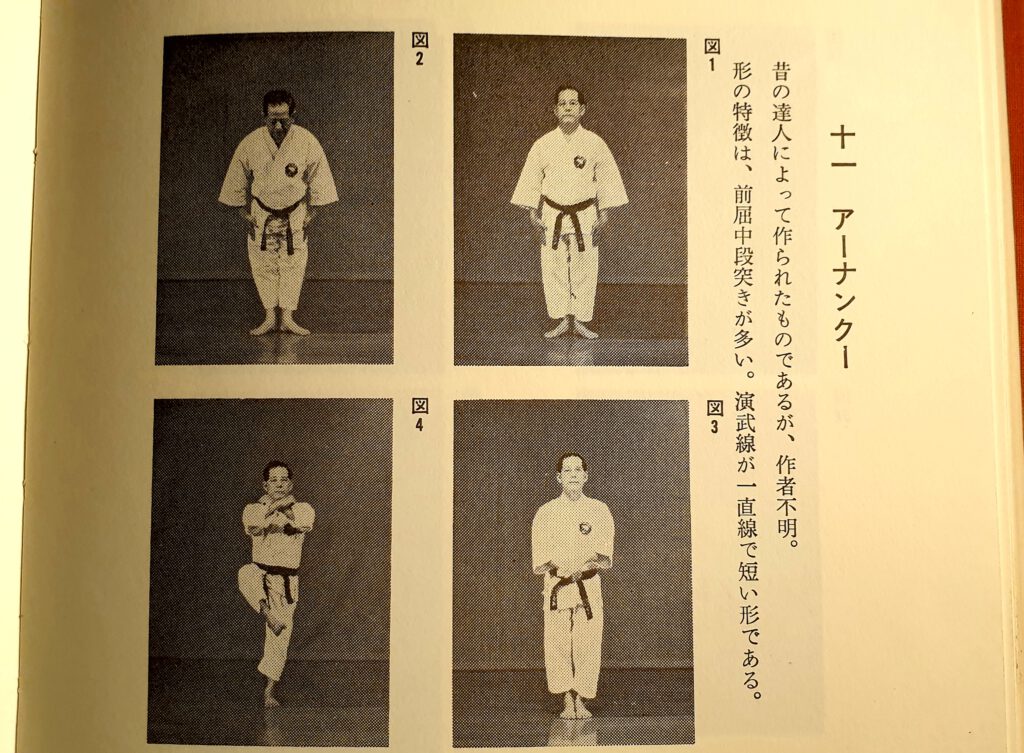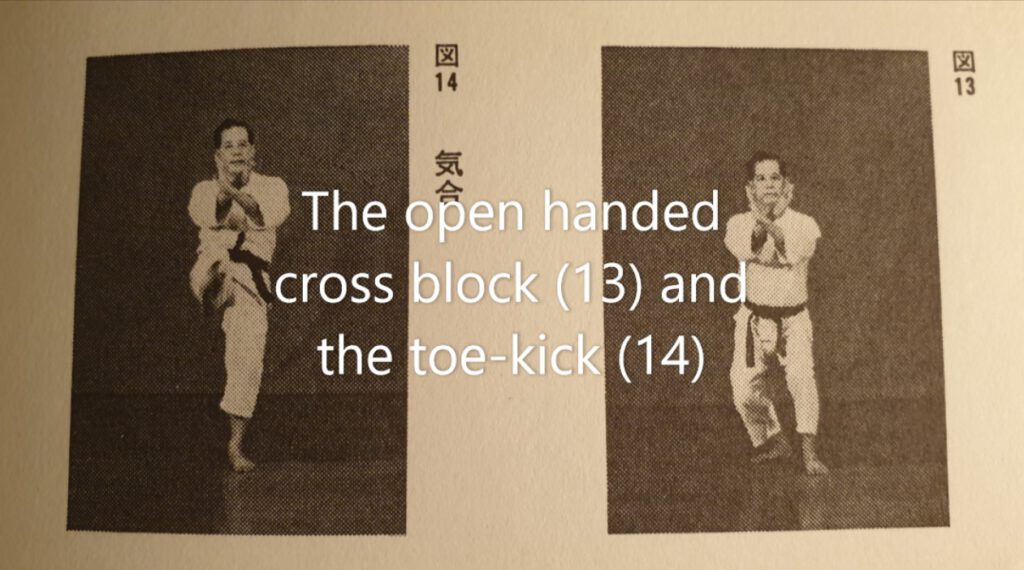Is there an old and a new version of Ānankū? In his book on kata, Nagamine Shōshin included a short paragraph about the original creator and the characteristics of each kata. Below is my English translation of the short Japanese entry (Nagamine 1975: 234).
“Ānankū. This [kata] was created by a past master, but this creator is unknown. The characteristics of this kata are many zenkutsu chūdan-zuki (mid-level thrusts in forward-bent stance). It is a short kata with a straight line as its enbusen (route of martial performance).”
While Ānankū of Matsubayashi-ryū is short and has a medium level of technical difficulty, it is a unique kata. It includes some signature techniques reminiscent of Chintō, such as the open-handed cross-block, or the rather specific abdomen toe-kick, which was a specialty of Arakaki Ankichi. In any case, while the open-handed cross-block with tow-kick is a snapshot-similarity with Chintō, it clearly has a different entry and exit than it has in Ānankū, and is, therefore, a mere punctual concordance.
Nagamine Sensei did not say from whom he learned Ānankū, but only that it “was created by a past master” and that this master “is unknown.”
The above is interesting because people from other schools have tried to make sense of Matsubayashi-ryū’s Ānankū, unsuccessfully I might add. They claim that this Ānankū is a creation by Nagamine Sensei himself. I think this claim is embryonic and without merit. This is because Nagamine Sensei in 1975 wrote that Ānankū “was created by a past master” and that this master “is unknown.”
The other Ānankū – according to a narrative by the Seibukan – was created by Kyan. Or, it was taught by Kyan to Shimabukuru Zenryo. Or, in an older narrative by the same school, Kyan learned it from a Chinese person in Taiwan. Or, as it was often the case in the postwar era, the kata was actually created by a student and retrospectively ascribed to a famous person and a corresponding narrative provided to it. BTW, when did this Ānankū first appear in (any kind of) record? It seems 1969 in an Okinawa Times article.
This Ānankū is not a unique kata. Rather, it is a simple mixture of combos taken from other kata and put together on some enbusen. Below I have added the morphological analysis of Ānankū and the kata the individual combos were taken from.
- opening gesture (standard gesture for kata in Seibukan)
- 1. left Shutō-uke / Neko-ashi-dachi 45° to left front (typical karate, for example, in Pinan Shodan, Kūsankū)
- 2. right Shutō-uke / Neko-ashi-dachi 45° to right front (typical karate, for example, in Pinan Shodan, Kūsankū)
- 3. left Uchi-uke / Renzoku Gyaku-/Choku-tsuki in Zenkutsu -dachi 90° to the left (as in Seisan)
- 4. right Uchi-uke / Renzoku Gyaku-/Choku-tsuki in Zenkutsu -dachi 90° to the right (as in Seisan)
- 5. Same as opening gesture (standard gesture for kata in Seibukan)
- 6. right Uchi-uke left Jōdan-uke (as in Passai)
- 7. Both-handed mid-level scissor strike (as in Passai)
- 8. Right choku-zuki (as in Passai)
- 9. Left Uchi-uke / Renzoku Gyaku-/Choku-tsuki / right Mae-geri / Gyaku-zuki (as in Gojūshiho)
- 10. Right Uchi-uke / Renzoku Gyaku-/Choku-tsuki / left Mae-geri / Gyaku-zuki (as in Gojūshiho)
- 11. Right Mawashi Enpi-uchi (Kūsankū)
- 180° turn
- 12. left Gedan-barai
- 13. Right Choku-zuki
- 14. Right Uchi-uke, step left foot forward in Bensoku-dachi / right Mae-geri and place right foot to front / right Gedan-barai / left Gyaku-zuki / right Uchi-uke (as in Seisan)
- 180° turn
- 15. Right Shutō-uke (typical karate, for example, in Kūsankū, Rōhai)
- 16. (right foot back) left Shutō-uke (typical karate, for example, in Kūsankū, Rōhai)
- End gesture (standard)
BTW, there is Sunabe Shozen, who in a karate magazine interview said he was a student of Kyan Chōtoku and that Kyan actually taught an Ānankū Shō and an Ānankū Dai. While I believe that he is the only person who ever said so, this would explain the existence of different Ānankū today. On the other hand, you cannot trust karate magazines, because they are just advertising brochures of the affiliated karate organizations and their narratives.
In any case, Ānankū of Matsubayashi-ryū is truly unique in technical content and enbusen and it is the oldest extant version of Ānankū that otherwise has not been handed down within the Okinawa Karate circles. Seen from this perspective, Ānankū of Matsubayashi-ryū is unique in history.
© 2020, Andreas Quast. All rights reserved.


